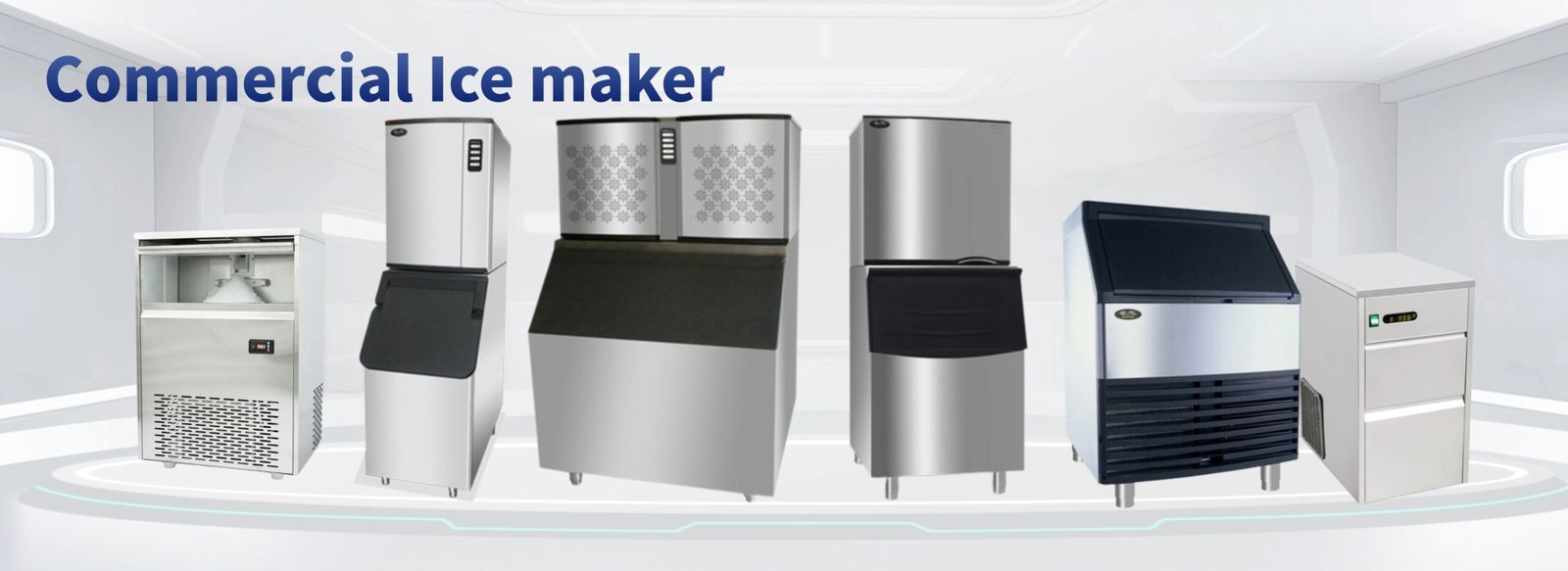Inhaltsübersicht
Umschalten aufEis hat eine gute Kältespeicherleistung und niedrige Temperatureigenschaften, weshalb es in der Fischerei, der chemischen Industrie, der Klimatechnik und anderen Branchen sowie bei großen Betonprojekten weit verbreitet ist.
Die Nachfrage der Kunden nach Qualität und Quantität des Eises wächst und ändert sich ständig, und die Eisbereitungsanlagen ändern sich ständig mit, und verschiedene Arten von kommerziellen Eis Hersteller aufgetaucht.
In diesem Blog werden wir uns die Arten von Eisbereitungsmaschinen nach verschiedenen Klassifizierungsstandards ansehen.
1. Was sind die verschiedenen Arten von Eisbereitern?
Gewerbliche Eisbereiter sind Kältemaschinen, die Wasser durch einen Verdampfer kühlen und Eis durch das Kältemittel im Kühlsystem erzeugen.
- Je nach Verwendungszweck können Eismaschinen in gewerbliche Eismaschinen und industrielle Eismaschinen unterteilt werden.
- Gewerbliche Eisbereiter gibt es in 2 Ausführungen: Split-Eisbereiter und integrierte Eisbereiter
- Je nach Form des Eises lassen sich die Eismaschinen in Würfeleis, Schneeflockeneis, Scherbeneis, Kugeleis, Röhreneis und Blockeis unterteilen.
- klassifiziert nach Struktur: Typ mit fließendem Wasser und Typ mit Eintauchen, je nach Art der Eisherstellung.
- Die Kältetechnik lässt sich unterteilen in: wassergekühlte Eismaschine, luftgekühlte Eismaschine.
2. Gewerblicher Eisbereiter VS Industrieller Eisbereiter
Kommerzieller Eisbereiter
Im Vergleich zu den industriellen Eisbereitern ist die Kapazität der kommerziellen Eisbereitungsmaschinen geringer, und die kommerziellen Eisbereitungsmaschinen können so lange verwendet werden, wie sie an die Stromversorgung angeschlossen sind.
Gewerbliche Eisbereiter mit größerer Eisproduktion sind in der Regel geteilt, und einige ähneln sogar den industriellen Eisbereitern.

Gewerbliche Eisbereitungsmaschinen eignen sich vor allem für Supermärkte, Convenience Stores, den Einzelhandel, die lebensmittelverarbeitende Industrie, Hotels und Restaurants, Verkehrs- und Zivilluftfahrtsysteme, westliche Schnellrestaurants usw.
Industrieller Eisbereiter
Industrielle Eisbereiter haben eine größere Eisproduktionskapazität und benötigen ein entsprechendes Kältesystem. Auch bei den Nutzungsanforderungen gibt es große Unterschiede. Industrielle Eiswürfelbereiter erfordern oft nicht standardisierte Produkte und Kühlung und entsprechendes zirkulierendes Wasser, elektronisches Steuerungssystem, Vorfertigung im Werk und Montage vor Ort. Daher müssen industrielle Eisbereiter über starke professionelle technische Fähigkeiten verfügen.
Sie werden hauptsächlich in großen Eisverarbeitungsbetrieben, in der Lebensmittelverarbeitung, im Fischhandel, in der chemischen Industrie, in der Wasser- und Elektrizitätswirtschaft, in der Medizin, im Bauwesen, im Bergbau und im Maschinenbau zur Kühlung, Lagerung und Konservierung eingesetzt.

Wenn Sie die Merkmale kommerzieller und industrieller Eisbereiter kennen, können Sie die Produkteigenschaften nutzen, um den Eisbereiter besser auf Ihre Bedürfnisse abzustimmen.
3. Split-Eismaschine VS integrierter Eisbereiter
- Split-Eismaschine
Eine geteilte Eismaschine besteht aus zwei Teilen: dem Kopf, d. h. dem "Eiserzeugungssystem", und dem Eiskübel.
Split-Eismaschinen haben eine unterschiedliche Leistung, die von 150 kg bis 900 kg in 24 Stunden reicht. Das Fassungsvermögen des Eisspeichers kann je nach Verwendung bestimmt werden und reicht von 100 kg bis 500 kg.
Da der Eiskübel nur eine kurzfristige Wärmespeicherkapazität hat, müssen Sie einen Eiskübel mit angemessenem Fassungsvermögen auf der Grundlage des geschätzten Eisverbrauchs wählen.
- Integrierter Eiswürfelbereiter
Wie der Name schon sagt, handelt es sich bei einer integrierten Eismaschine, die auch als "Untertisch-Eismaschine" bezeichnet wird, um ein Eisbereitungsgerät, das Eisbereitungs- und Eisspeichersysteme integriert und unter der Theke installiert werden kann.
Diese Art von Eismaschine ist einfach zu installieren und zu bedienen, einfach einstecken und an das Wasser anschließen.
Integrierte Eismaschinen werden im Allgemeinen in Bars oder kleinen Restaurants mit geringem Kundenaufkommen eingesetzt. Die Nennleistung von gewerblichen Untertisch-Eismaschinen liegt im Allgemeinen zwischen 25 kg und 140 kg pro 24 Stunden.
4. Eisbereiter für verschiedene Eisformen
Die üblichen Formen von Eis, die von gewerblichen Eismaschinen hergestellt werden, sind Würfeleis, Mineraleis, Schneeflockeneis, Scherbeneis, Röhreneis und Kugeleis. Mit industriellen Eismaschinen wird hauptsächlich Röhreneis, Würfeleis, Scherbeneis und Brickeis hergestellt.
Die Form des Eises bestimmt seine unterschiedlichen Eigenschaften, so dass es verschiedene Einsatzmöglichkeiten gibt.
- Strukturelle Klassifizierung
Je nach Art der Wasserversorgung können drei Typen unterschieden werden: Sprühtyp, Eintauchtyp und Durchflusstyp.
- Spray Eiswürfelbereiter
Die Wasserpumpe sprüht Wasser auf den Verdampfer an der Oberseite, und die Verdampfer-Eisschale ist horizontal installiert. Die mit dieser Methode hergestellten Eiswürfel haben eine hohe Härte, eine niedrige Temperatur (die Temperatur von Eiswürfeln kann unter -20℃ liegen), eine ausgezeichnete Textur und eine lang anhaltende Kühlwirkung.
- Immersions-Eisbereiter
Die Eisherstellung durch Eintauchen ist schnell, das Eis sieht schön aus, und die Schiebetür hat ein einzigartiges Schiebedesign, das sich flexibel öffnen lässt.
- Fließender Eisbereiter
Bei der Fließeisherstellung fließt das Wasser vom oberen Teil der Eisschale durch die Schwerkraft des Wassers durch die Eisschale, und die Eisschale ist vertikal installiert. Die mit dieser Methode hergestellten Eiswürfel sind nicht so hart wie die des Sprühverfahrens, aber das Eisproduktionsvolumen ist groß und die Effizienz ist hoch, was sich für Gelegenheiten mit hohem Eisverbrauch eignet.
5. Verschiedene Kühlungsmethoden
Der Kompressor erzeugt beim Verdichten von Gas viel Wärme, die abgeführt werden muss.
Die Methode, einen Ventilator zu verwenden, um einen Luftstrom zu erzeugen und ihn zum Zylinder zu blasen, um die Wärme zu entfernen, wird als LuftkühlungDie Herstellung eines doppelschichtigen Zylinders und das Durchleiten von zirkulierendem Wasser in der Mitte zur Ableitung der Wärme wird als Wasserkühlung.
6. Schlussfolgerung
Eisbereiter spielen in allen Bereichen unserer Arbeit und unseres Lebens eine wichtige Rolle. Dieser Artikel stellt die Arten von Eisbereitern vor, indem er verschiedene Klassifizierungsmethoden vorstellt. Ich glaube, er kann den Lesern helfen, Eisbereiter besser zu verstehen.






